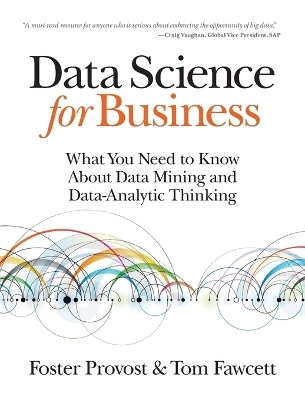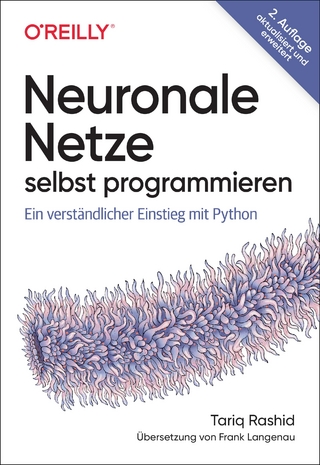
Data Science for Business
O'Reilly Media, Inc, USA (Verlag)
978-1-4493-6132-7 (ISBN)
Written by renowned data science experts Foster Provost and Tom Fawcett, Data Science for Business introduces the fundamental principles of data science, and walks you through the "data-analytic thinking" necessary for extracting useful knowledge and business value from the data you collect. This guide also helps you understand the many data-mining techniques in use today.
Based on an MBA course Provost has taught at New York University over the past ten years, Data Science for Business provides examples of real-world business problems to illustrate these principles. You’ll not only learn how to improve communication between business stakeholders and data scientists, but also how participate intelligently in your company’s data science projects. You’ll also discover how to think data-analytically, and fully appreciate how data science methods can support business decision-making.
- Understand how data science fits in your organization—and how you can use it for competitive advantage
- Treat data as a business asset that requires careful investment if you’re to gain real value
- Approach business problems data-analytically, using the data-mining process to gather good data in the most appropriate way
- Learn general concepts for actually extracting knowledge from data
- Apply data science principles when interviewing data science job candidates
Foster Provost is a Professor and NEC Faculty Fellow at the NYU Stern School of Business, where he has taught data science to MBAs for 15 years. His research and teaching focus on data science, machine learning, business analytics, (social) network data, and crowd-sourcing for data analytics. Tom Fawcett has a Ph.D. in machine learning from UMass-Amherst and has worked in industrial research (GTE Laboratories, NYNEX/Verizon Labs, HP Labs, etc.). He has served as action editor of the Machine Learning journal, before which he was an editorial board member.
Chapter 1 Introduction: Data-Analytic Thinking
The Ubiquity of Data Opportunities
Example: Hurricane Frances
Example: Predicting Customer Churn
Data Science, Engineering, and Data-Driven Decision Making
Data Processing and “Big Data”
From Big Data 1.0 to Big Data 2.0
Data and Data Science Capability as a Strategic Asset
Data-Analytic Thinking
This Book
Data Mining and Data Science, Revisited
Chemistry Is Not About Test Tubes: Data Science Versus the Work of the Data Scientist
Summary
Chapter 2 Business Problems and Data Science Solutions
From Business Problems to Data Mining Tasks
Supervised Versus Unsupervised Methods
Data Mining and Its Results
The Data Mining Process
Implications for Managing the Data Science Team
Other Analytics Techniques and Technologies
Summary
Chapter 3 Introduction to Predictive Modeling: From Correlation to Supervised Segmentation
Models, Induction, and Prediction
Supervised Segmentation
Visualizing Segmentations
Trees as Sets of Rules
Probability Estimation
Example: Addressing the Churn Problem with Tree Induction
Summary
Chapter 4 Fitting a Model to Data
Classification via Mathematical Functions
Regression via Mathematical Functions
Class Probability Estimation and Logistic “Regression”
Example: Logistic Regression versus Tree Induction
Nonlinear Functions, Support Vector Machines, and Neural Networks
Summary
Chapter 5 Overfitting and Its Avoidance
Generalization
Overfitting
Overfitting Examined
Example: Overfitting Linear Functions
* Example: Why Is Overfitting Bad?
From Holdout Evaluation to Cross-Validation
The Churn Dataset Revisited
Learning Curves
Overfitting Avoidance and Complexity Control
Summary
Chapter 6 Similarity, Neighbors, and Clusters
Similarity and Distance
Nearest-Neighbor Reasoning
Some Important Technical Details Relating to Similarities and Neighbors
Clustering
Stepping Back: Solving a Business Problem Versus Data Exploration
Summary
Chapter 7 Decision Analytic Thinking I: What Is a Good Model?
Evaluating Classifiers
Generalizing Beyond Classification
A Key Analytical Framework: Expected Value
Evaluation, Baseline Performance, and Implications for Investments in Data
Summary
Chapter 8 Visualizing Model Performance
Ranking Instead of Classifying
Profit Curves
ROC Graphs and Curves
The Area Under the ROC Curve (AUC)
Cumulative Response and Lift Curves
Example: churnperformance analytics for modeling performance analytics, for modeling churn Performance Analytics for Churn Modeling
Summary
Chapter 9 Evidence and Probabilities
Example: Targeting Online Consumers With Advertisements
Combining Evidence Probabilistically
Applying Bayes’ Rule to Data Science
A Model of Evidence “Lift”
Example: Evidence Lifts from Facebook "Likes"
Summary
Chapter 10 Representing and Mining Text
Why Text Is Important
Why Text Is Difficult
Representation
Example: Jazz Musicians
* The Relationship of IDF to Entropy
Beyond Bag of Words
Example: Mining News Stories to Predict Stock Price Movement
Summary
Chapter 11 Decision Analytic Thinking II: Toward Analytical Engineering
Targeting the Best Prospects for a Charity Mailing
Our Churn Example Revisited with Even More Sophistication
Chapter 12 Other Data Science Tasks and Techniques
Co-occurrences and Associations: Finding Items That Go Together
Profiling: Finding Typical Behavior
Link Prediction and Social Recommendation
Data Reduction, Latent Information, and Movie Recommendation
Bias, Variance, and Ensemble Methods
Data-Driven Causal Explanation and a Viral Marketing Example
Summary
Chapter 13 Data Science and Business Strategy
Thinking Data-Analytically, Redux
Achieving Competitive Advantage with Data Science
Sustaining Competitive Advantage with Data Science
Attracting and Nurturing Data Scientists and Their Teams
Examine Data Science Case Studies
Be Ready to Accept Creative Ideas from Any Source
Be Ready to Evaluate Proposals for Data Science Projects
A Firm’s Data Science Maturity
Chapter 14 Conclusion
The Fundamental Concepts of Data Science
What Data Can’t Do: Humans in the Loop, Revisited
Privacy, Ethics, and Mining Data About Individuals
Is There More to Data Science?
Final Example: From Crowd-Sourcing to Cloud-Sourcing
Final Words
Appendix Proposal Review Guide
Business and Data Understanding
Data Preparation
Modeling
Evaluation and Deployment
Appendix Another Sample Proposal
Scenario and Proposal
Glossary
Appendix Bibliography
Index
Colophon
| Erscheint lt. Verlag | 17.9.2013 |
|---|---|
| Zusatzinfo | colour illustrations |
| Verlagsort | Sebastopol |
| Sprache | englisch |
| Maße | 152 x 229 mm |
| Gewicht | 635 g |
| Einbandart | kartoniert |
| Themenwelt | Informatik ► Datenbanken ► Data Warehouse / Data Mining |
| Wirtschaft ► Betriebswirtschaft / Management ► Unternehmensführung / Management | |
| ISBN-10 | 1-4493-6132-3 / 1449361323 |
| ISBN-13 | 978-1-4493-6132-7 / 9781449361327 |
| Zustand | Neuware |
| Informationen gemäß Produktsicherheitsverordnung (GPSR) | |
| Haben Sie eine Frage zum Produkt? |
aus dem Bereich


